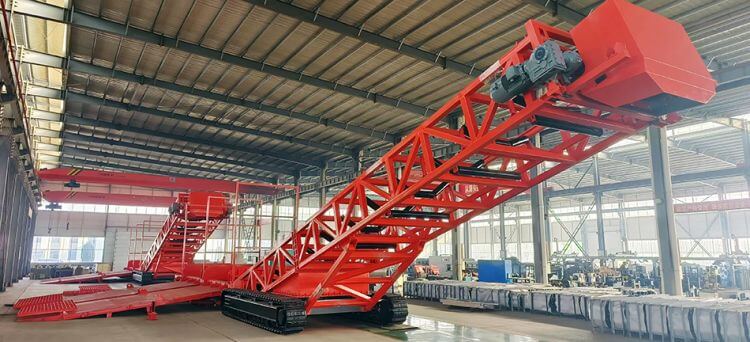In today's rapidly advancing global industry, bulk material transportation and handling have become critical operational links across multiple sectors. From mining and port logistics to construction materials production and energy supply, the efficient transfer and processing of bulk materials—such as coal, ore, sand, grain, and more—directly impact enterprise productivity and operational costs. In this context, the truck unloader serves as a core asset in bulk material handling, playing an indispensable role. Zoomry with years of expertise in bulk conveying equipment, provides global clients with high-quality truck unloaders and comprehensive bulk material handling solutions.

Importance of the Truck Unloader in Bulk Material Handling
In modern industrial production and logistics systems, bulk material transport primarily relies on trucks for short-to-medium-distance transfers. Traditional manual or basic mechanical unloading methods suffer from inefficiency, safety risks, and high labor costs, failing to meet large-scale, high-efficiency demands. The advent of the truck unloader revolutionized this landscape. It enables rapid, automated unloading of bulk materials from trucks, significantly boosting handling efficiency and safety while reducing operational costs. Whether unloading mined ore for storage/processing in mines or swiftly transferring imported coal/grain at ports, the truck unloader performs irreplaceably. Zoomry’s truck unloaders, with their superior performance and reliability, are the preferred choice for enterprises seeking enhanced bulk handling capabilities.
Structure and Working Principle of the Truck Unloader
Structural Components
Zoomry’s truck unloader comprises a wheeled or crawler chassis, unloading ramp, receiving hopper, conveying system, hydraulic control system, and electrical control system. The wheeled/crawler chassis ensures mobility and adaptability across diverse terrains. The unloading ramp—critical for truck positioning—features a carefully calculated incline and load-bearing capacity to ensure safe, smooth material discharge. The receiving hopper collects bulk materials and directs them into the conveying system. The conveying system transfers materials to designated locations. Hydraulic and electrical systems act as the "brain" and "nerves," automating operations through precise component control.
Working Principle
The truck unloader operates via hydraulic transmission and automated electrical control. When a loaded truck enters the unloading ramp, sensors detect its position, triggering the hydraulic system. The hydraulic system adjusts the ramp angle for optimal unloading. The truck driver raises the cargo box, allowing materials to slide down the ramp into the hopper by gravity. Materials then enter the conveying system (e.g., belt or screw conveyors) for transfer to storage, processing units, or other transport. Throughout the process, the electrical system monitors all parameters to ensure safety and efficiency.
Bulk Material Handling Process Using the Truck Unloader
Preparation Phase
Before unloading, operators must conduct comprehensive checks: verify hydraulic oil levels/pressure, electrical connections, bolt tightness, and belt tension. After confirming optimal conditions, adjust parameters (ramp angle, belt speed) based on material type and downstream needs. Trucks should be guided to designated lanes and positioned precisely on the ramp.
Unloading Phase
Once the truck is correctly positioned, the driver raises the cargo box. Materials slide down the specially treated ramp (designed for wear resistance and smooth flow) into the receiving hopper. The hopper’s geometry ensures uniform material entry into the conveying system. Monitoring systems track material flow and trigger alarms or adjustments for blockages or flow abnormalities.
Conveying Phase
Materials enter conveying systems tailored to material properties (e.g., belt or screw conveyors). In belt systems, gravity and friction move materials forward. Belt speeds adjust to match flow rates and downstream capacity. Enclosures and dust suppression systems minimize spillage and environmental impact.
Completion Phase
After unloading, the driver lowers the cargo box and exits the ramp. Operators then clear residual materials from the hopper and conveyors, record operational data, and conduct post-operation inspections. Any malfunctions require immediate troubleshooting to ensure readiness for the next cycle.
Advantages of Zoomry’s Truck Unloader
Efficiency
Engineered with advanced designs, Zoomry’s truck unloader achieves unloading capacities up to 1,800 tph. Automated processes reduce manual intervention, enhancing continuity and efficiency by orders of magnitude versus traditional methods.
Safety
Multi-layered safety features include belt deviation sensors, emergency stops, and overload protection. Anti-slip ramp surfaces, structural stability, and automated operations minimize human-contact risks.
Flexibility & Adaptability
Configurations include wheeled or crawler chassis, varied ramp sizes, and conveying systems—ensuring optimal solutions for ports, mines, or construction sites.
Reliability & Durability
Critical components (hydraulic systems, controls, belts) undergo rigorous testing. Premium materials and precision manufacturing ensure longevity in harsh environments. Comprehensive after-sales support includes maintenance and troubleshooting.
Application Scenarios
Mining Industry
Rapidly unloads ore from trucks to crushers or storage, boosting productivity in rugged terrains.
Port Logistics
Accelerates transfer of ship-unloaded bulk goods to warehouses, reducing vessel turnaround times and logistics costs.
Building Materials Sector
Streamlines raw material (e.g., sand, limestone) unloading for seamless production line integration, minimizing material loss.
Energy Sector
Ensures efficient coal unloading at power plants for consistent fuel supply to generators.
Zoomry leverages decades of expertise to deliver high-performance truck unloaders and end-to-end bulk handling solutions. By mastering the unloading process and recognizing the truck unloader's versatility across industries, clients gain competitive advantages and sustainable growth. As technology evolves, the truck unloader’s role will expand—and Zoomry remains committed to its vision: "Crafting Conveying Excellence, Building a Legacy for Generations."

 ZOOMRY
ZOOMRY

